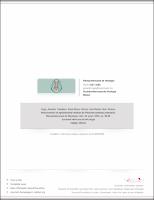Bioconversion of agroindustrial residues by Pleurotus ostreatus cultivation
Fecha
2005Autor
Vega, Aracelly
Mata, Gerardo
Salmones, Dulce
Caballero, Rosa Elena
Metadatos
Mostrar el registro completo del ítemResumen
Edible mushrooms are able to bioconvert a wide variety of
lignocellulosic materials due to the secretion of extracellular
enzymes [3, 11]. Literature reports that the bioconverted materials show an increase in their protein contents and a decrease in their fiber content[10,15] being possibly used as
ruminant feed supplements [4, 5].
Traditionally, the evaluation of the quality of the
converted materials is under the same criteria as those applied
to the evaluation of conventional forages [14]. Nutrient
availability is evaluated by chemical analyses such as dry
matter, ash, protein, lignin, cellulose and hemicellulose
determinations. Digestibility is evaluated through in vitro and
in vivo assays and palatability suppose feed selection trials
with whole animals [1, 8].
There is an increasing tendency to avoid animal
experimentation. This implies the usage of even more indirect
assays for the estimation of digestibility. For instance, Japan
Livestock Technology Association recommends an
enzymatic fractionation of dry matter into cell contents and
cell wall. In turn, these are also fractionated in organic cell
contents and organic cell wall. Cell wall is further divided into
high digestibility and low digestibility fractions. Organic cell
contents and the high digestibility fraction are assigned with a
100% and 95-100% digestibility respectively. Depending on
the assayed material, the low digestibility fraction may have
from 40% to 50% digestibility [9]

